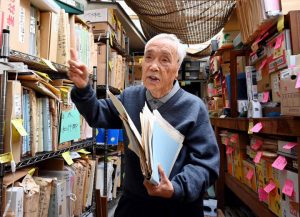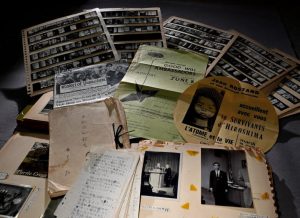Striving to fill voids in Hiroshima—Hiromu Morishita seeking organization for donation of post-war materials related to A-bombed city of Hiroshima
Apr. 16, 2022
Tens of thousands of materials include those related to World Peace Pilgrimage and Hiroshima Hachiroku no Tomo no Kai group’s newsletter
by Michiko Tanaka, Staff Writer
Hiromu Morishita, 91, an atomic bomb survivor who has put tremendous effort into peace activities since he was in his 20s, has held on to tens of thousands of peace-related materials at his home in Hiroshima’s Saeki Ward. The materials include rare items of a kind that are not archived anywhere, even in the Hiroshima Peace Memorial Museum, located in the city's Naka Ward. One specialist describes Mr. Morishita’s materials as being of extremely high historical value. Mr. Matsushita is now organizing his materials to pass on to future generations and looking for a public organization to which to donate everything.
Mr. Morishita’s materials cover a wide range. For instance, he has held on to materials related to the 1964 World Peace Pilgrimage, a project originally proposed by the late Barbara Reynolds, an American peace activist who later became an Honorary Citizen of Hiroshima. Mr. Morishita joined the unprecedented project, in which a group of A-bomb survivors toured Western countries to speak of their A-bombing experiences. He also has kept materials that give an overall picture of the journey, including a list of participants, an itinerary, and more than 1,000 photographs.
During the pilgrimage, the participants met with Harry Truman, the U.S. president at the time of the atomic bombing, as the first A-bomb survivors to do so. Along with a photograph capturing that historic moment, Mr. Morishita has held on to notes in which he wrote details of the conversation and his thoughts about the occasion.
Mr. Morishita, then aged 14, experienced the atomic bombing about 1.5 kilometers from the hypocenter, where he had been mobilized for the war effort. At the time he was a third-year student at the First Hiroshima Prefectural Junior High School (now Hiroshima Kokutaiji High School). His mother died in the atomic bombing and he suffered burns on his face, arms, and legs. After graduating from Hiroshima University, he became a calligraphy teacher at a local high school and, at the same time, devoted his energies to peace education. In 1963, Mr. Morishita initiated a survey on his own initiative about the consciousness of high school students regarding the atomic bombing, an effort that grew to include other areas of Hiroshima Prefecture, as well as other prefectures in Japan, and that continued until 1985. The original responses from each year of the survey are included among Mr. Morishita’s materials.
Mr. Morishita has also held on to mimeographed copies of the first-through-fourth issues of the newsletter of the Hiroshima Hachiroku Tomo no Kai, an A-bomb survivors group that was led by, among others, the late Kiyoshi Kikkawa, who was dubbed “Atomic Bomb Victim No. 1” by the media and operated a souvenir shop near the Atomic Bomb Dome, located in the city's Naka Ward. The first issue, published in 1955, reported on the death of Sadako Sasaki, who later became the model on which was based the Children’s Peace Monument, along with other news. The Hiroshima Peace Memorial Museum has reported it does not possess a copy of that particular issue.
Mr. Morishita stressed, “I made efforts to record as much as possible to leave behind facts about what happened. I hope to find an organization that will archive the materials appropriately, making it possible for people to learn about the atomic bombing in a future in which A-bomb survivors are no longer with us.” Akiko Kubota, assistant professor at the Hiroshima University’s Research Institute for Radiation Biology and Medicine (RIRBM) who examined the materials two years ago, said, “The materials are of a great variety. Each of the materials is valuable, with some enabling us to trace the early days of the A-bomb survivors movement.” Ms. Kubota added, “The materials should be preserved all together to prevent them from being scattered and lost.”
(Originally published on April 16, 2022)









